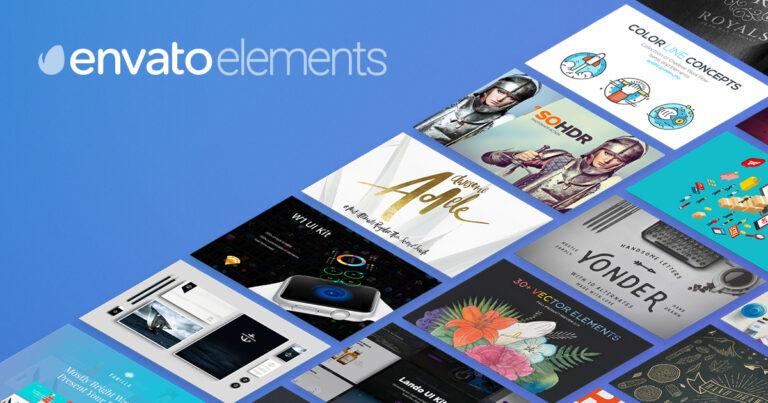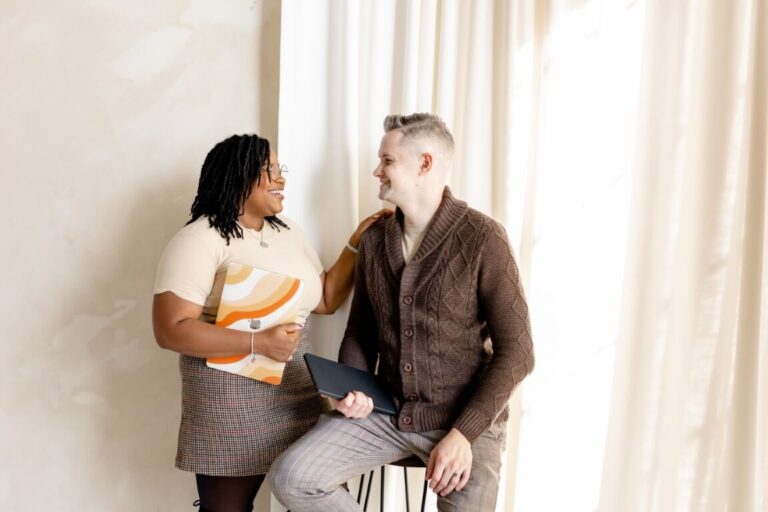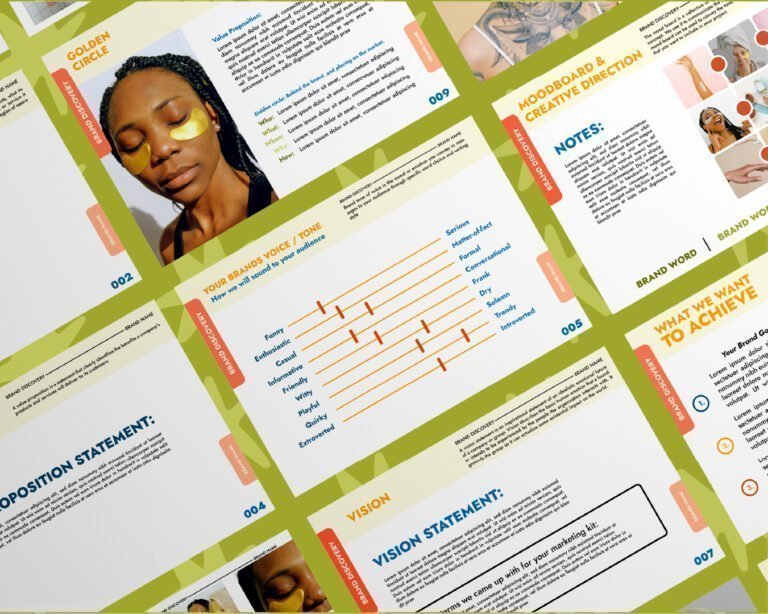Believe it or not, 48% of people cite a company’s design, a key component of brand identity, as the most telling factor about its credibility. This underscores the importance of graphic designers and digital designers who fulfill creative designer responsibilities in shaping how a brand is perceived.
A creative designer, whether a graphic designer, digital designer, motion graphics designer, or artist, taps into this power, blending understanding and concepts to forge a visual connection that speaks volumes.
Graphic designers, artists, and art directors are the maestros behind the captivating project visuals you see in print or online, with creative directors crafting portfolios that scream innovation. Whether it’s a creative director shaping a company’s public relations through a snappy website, a creative designer sketching out the next big product, or graphic designers and graphic designer interns infusing their artistry into visual elements, their work is everywhere.
And with each stroke of creativity, the creative designer isn’t just making things look pretty; they’re driving home your message with visual design that sticks long after the viewer has scrolled on. Whether as a creative director or motion graphics designer, their impact resonates.
From short essays to complex industry communications, these unsung heroes, often graphic designers or creative designers, wield their ability to turn information into visual stories that resonate. Even graphic designer interns contribute to crafting compelling visuals that underpin the narratives. In an age where every member of society is bombarded by information, graphic designers in marketing ensure your message doesn’t just whisper; it roars through compelling motion graphics.
Deciphering the Role of a Creative Designer
Creative designers are key players in shaping visual content. Graphic designer interns and seasoned graphic designers work with marketing teams to ensure brand consistency and have various career paths, including becoming a creative designer.
Core Responsibilities
A creative designer turns ideas into visuals. Their job is to make concepts come alive. Creative designers and graphic designers, along with graphic designer interns, take on design projects from start to finish, ensuring each piece aligns with a brand’s identity and often incorporating motion graphics to enhance visual appeal. This role demands close collaboration with others, often working alongside marketers, writers, product teams, and graphic designers. Creative designers and graphic designer interns will join these workers in a dynamic environment.
Graphic designers not only create but also guide the creative designer process, impacting workers’ employment in the design field. A creative designer, an occupation crucial to maintaining a company’s brand identity, ensures that every graphic or layout reflects the company’s style and message consistently across all platforms, thereby enhancing the employment experience for all workers and potentially impacting salary structures through their valuable contributions. Graphic designers often face the challenge of creating a logo that maintains its impact and meaning across various platforms—whether it’s displayed on websites, business cards, or billboards. This task is crucial for a creative designer seeking employment in May, as versatility in design is highly sought after.
Career Trajectories
Starting as a junior graphic designer, one can climb to senior roles with increased salary, leading to employment opportunities in various design occupations, like becoming a creative director. The journey of a creative designer involves mastering various graphic design skills and understanding strategic branding, which are crucial for employment in design-related occupations. In this field, experience counts for a lot.
Creative designers find opportunities in many industries. From tech startups to fashion houses, graphic designers and creative designers find their skills in high demand everywhere, offering diverse employment opportunities for these skilled workers. Some choose the stability of an in-house employment position with a consistent salary, while others opt for the freedom of freelance work as independent workers pursuing their chosen occupation.
The stats indicate that freelancing is becoming a more popular form of employment among creatives, especially graphic designers, with the occupation offering competitive salary prospects. In recent years, there’s been a significant increase in those choosing the occupation of graphic designers or creative designer over traditional employment—offering them diverse projects, flexible schedules, and competitive salaries.
Creative vs Graphic Designers
It’s easy to confuse the occupation of creative designers with that of graphic designers—but they’re different in employment roles and potential salary! A creative designer, within their occupation, focuses more on concept development, while graphic designers seek employment concentrating on creating specific visual elements.
Their scope of work varies too. Creative designers often oversee entire campaigns or product launches in the employment sector; graphic designers might focus on one piece like a brochure or advertisement within their employment roles.
Project objectives differ as well. For example, in the employment sector, a creative designer aims to establish an overall aesthetic for a brand, while graphic designers might be tasked with making sure that aesthetic works on different materials or formats within their employment roles.
Essential Skills for a Flourishing Creative Designer
Creative designers seeking employment must master technical skills and soft skills while understanding user experience fundamentals. The role of a creative designer is multifaceted, requiring a blend of artistic ability and practical know-how, essential for graphic designers seeking employment.
Technical Proficiencies Required
Creative designers need to be wizards with design software like Adobe Creative Suite. This mastery enables a creative designer to bring their visions to life, whether it’s a stunning graphic or an entire brand identity. Graphic designers know that mastering the ins and outs of creative design tools isn’t just about creating; it’s also about efficiency and precision in their work.
Graphic designers and creative designers should have a basic grasp of web development too. Even if graphic designers are not coding sites from scratch, understanding HTML, CSS, and JavaScript principles can help them communicate better with developers. It ensures that graphic designers’ creations are feasible and functional online.
Print production processes are another pillar of knowledge. A creative graphic designer should be familiar with how their digital designs translate into physical products. Graphic designers must be adept at selecting the right paper and understanding color management to ensure the final print material meets the high standards expected by clients.
Soft Skills and Their Importance
Communication is key in any job, but for creative designers, it’s vital. Graphic designers must convey ideas clearly to clients and collaborate effectively with team members. This skill can make or break a project’s success.
Time management is another non-negotiable skill. Designers often juggle multiple projects at once, each with its own deadline. For graphic designers, being able to prioritize tasks ensures that everything gets done on time without compromising quality.
Adaptability cannot be overstated for graphic designers in an industry where trends change at lightning speed. A successful graphic designer stays ahead of the curve by embracing new styles and technologies rather than being intimidated by them.
User Experience Fundamentals
User-centered design lies at the heart of what creative designers do. Every button placement or color choice by graphic designers has to make sense for the user first and foremost. Graphic designers understand these principles, which means they create more than just pretty things; they create useful things.
Graphic designers understand that usability testing is part of this process—a critical step that shouldn’t be skipped. Graphic designers often engage in a process that involves real users interacting with a product to identify any issues before launch. This feedback loop helps graphic designers refine their designs until they’re not just good but great.
Graphic designers integrating feedback into design improvements show a commitment to excellence—and humility too! It takes courage for designers to accept critiques but doing so leads to better outcomes for everyone involved: the designer grows, the product improves, and users are happier.
Educational Pathways in Creative Design
Creative designers craft visual concepts that inspire and inform. Graphic designers often have a diverse educational and experiential journey, including formal education, on-the-job training, and transitioning from related fields.
Degree Requirements
Most creative designers start with a Bachelor of Fine Arts (BFA) in Graphic Design. This degree offers a solid foundation in design principles. It’s not just about learning to draw or use software; it’s about understanding how graphic designers communicate visually.
Professional certifications can be game-changers. Becoming an Adobe Certified Expert showcases proficiency with industry-standard tools for graphic designers. These certifications can set graphic designers apart in a competitive job market.
Continuing education keeps designers at the top of their game. With technology and trends always evolving, courses and workshops help graphic designers keep their skills sharp. Graphic designers also open doors for career advancement as they demonstrate commitment to the profession.
Work Experience
Mentorship is like having a GPS for your career path—it guides graphic designers through the design landscape. Collaborating with seasoned graphic designers provides invaluable insights that no classroom can offer.
A portfolio is more than a collection of work; it’s your professional storybook. Including diverse projects shows versatility and skill range. It’s crucial to display work across various media platforms—print, digital, social media—to illustrate adaptability.
Experience matters in every pixel and vector you create. Working on different platforms—from websites to mobile apps—builds expertise that employers seek out.
Transitioning Careers
Many creative designers didn’t start out in design at all—they came from marketing, art, or IT backgrounds. These fields provide transferable skills like project management or technical know-how that are beneficial in design roles.
Cross-disciplinary training opens new perspectives. For example, understanding user experience (UX) principles can enhance graphic design skills significantly.
Networking isn’t just about collecting business cards; it’s building relationships within the design community. Attending events and joining online forums connects you with potential mentors, collaborators, and job opportunities.
The Creative Designer’s Professional Journey
Creative designers embark on a fascinating career path, from entry-level roles to leading design teams. They develop specialized skills and create impressive portfolios that showcase their unique artistic vision.
Entry-Level Positions and Progression
Starting as junior designers, individuals learn the ropes of the creative industry. They work under senior designers, tackling various tasks to build practical experience. A designer’s early career is often marked by learning through doing, with responsibilities growing as they prove their abilities.
The journey up the career ladder can be swift for those who shine. Within a few years, talented artists can become senior designers or art directors. Their success hinges on a robust portfolio that demonstrates growth and versatility in design.
Specializations within Creative Design
Designers may choose to specialize in areas like motion graphics or environmental design. These niches require specific skills that set artists apart from generalists. Specialists are often in high demand due to their focused expertise.
Choosing a niche has its perks. It allows designers to become authorities in their chosen field and stand out in the job market. For example, an artist focusing on motion graphics might work on exciting projects like animated films or video games.
Advancement Strategies in Creative Direction
Aspiring creative directors must hone leadership skills to guide teams effectively. Strategic thinking is crucial for leading projects and pushing creative boundaries. Success as a creative leader involves steering teams toward innovative solutions that resonate with audiences.
A track record of successful campaigns or projects paves the way for advancement into creative direction roles. Designers aspiring to these positions demonstrate an ability to inspire others and manage complex initiatives from concept to completion.
Work Environment and Lifestyle of a Creative Designer
Creative designers have diverse job titles and work in various settings. They balance demanding deadlines with personal well-being and seek opportunities in creative hotspots.
Multifaceted Job Titles
Creative designers wear many hats. Some become Art Directors or Visual Designers, showing their level of expertise. They may work in buzzing startups or established large corporations. The choice between freelancing and full-time in-house roles affects their daily lives. Freelancers enjoy flexibility but handle the uncertainty of gigs. In-house designers have stability but might face office politics.
Work-Life Balance
Finding harmony is crucial for creative minds. Designers juggle tight deadlines with life’s demands, striving to stay healthy and happy. Personal fulfillment drives their job satisfaction, often more than money does. Nowadays, many opt for remote work, which can offer freedom but requires self-discipline.
Career Growth Hotspots
Location matters for career advancement. Cities like New York and San Francisco are magnets for creatives due to their vibrant industries. Local culture influences design styles and opportunities available to a designer. Global remote work breaks geographical barriers, giving access to international projects and clients.
Financial Aspects of a Creative Design Career
Creative designers can expect varied salaries and benefits depending on their specialization and experience. The economic outlook for this career is also influenced by market trends and demand.
Salary Expectations
Pay varies widely in the creative design field. A UX/UI designer might earn more than someone focused on traditional graphic design due to the technical nature of their work. Experience plays a big role too. A seasoned designer with years under their belt could see significantly higher earnings compared to a newcomer.
Freelancers face a different scenario. They often charge by the project or hour, leading to fluctuating income streams. Full-time employees enjoy steadier paychecks, but freelancers may command higher rates overall for their flexibility and specialized skills.
Benefits Analysis
Full-time creative designers often receive robust benefits packages. Health insurance and retirement plans are pretty standard offerings from employers. These perks add substantial value to the overall compensation package.
But there’s room to negotiate beyond the basics. Some companies may offer allowances for continued education or flexible working hours, which can be critical for personal growth and work-life balance.
Equity or profit-sharing options are another avenue where designers can gain financially, particularly in startups or well-established firms that value employee investment in the company’s success.
Economic Outlook
The job market for creative designers is currently healthy, with steady employment rates reflecting ongoing demand for these skills. However, economic shifts can impact job availability across industries.
Factors like technological advancements and changes in consumer behavior influence how many design jobs are out there. For instance, as businesses increase their online presence, they need more digital design expertise.
Future demand looks positive with an expected growth in areas like virtual reality (VR) and user experience (UX) design, which are becoming increasingly important as technology evolves.
Future Prospects in Creative Designing Fields
Creative designers are shaping the future with their innovative ideas. They’re not just making things look good; they’re solving problems and changing how we interact with the world.
Job Outlook for Creative Professionals
The creative sector is buzzing. Jobs for designers are growing faster than average. This is because everything around us is designed, from the apps on our phones to the ads we see.
Digital media is a big reason why design jobs are booming. As more people spend time online, companies need skilled designers to grab their attention. This means if you’re good at creating cool graphics or websites, your skills are in high demand.
In the next ten years, certain design jobs will be super hot. Think about user experience (UX) designers or motion graphics specialists. These folks make sure that when you use an app or watch a video, it’s easy and fun.
Growth Projections and Emerging Niches
Technology keeps marching forward, and it’s opening up new playgrounds for designers. Virtual reality (VR) and augmented reality (AR) are two areas getting lots of buzz. If you can design experiences that mix real with digital worlds, you’re golden.
People’s habits change all the time, which shakes up the design industry too. For example, as more people shop online instead of in stores, e-commerce design becomes super important.
Sustainability isn’t just good for Earth; it’s also a growing field in design. Designers who can create products that don’t hurt the planet are going to be stars.
State and Area Data Insights for Creatives
Where you live can affect your chances of landing a great design job. Some states have loads of opportunities while others might not have as much going on.
Places like California and New York are where many creatives flock to because there’s so much happening there. But don’t count out other areas! Sometimes smaller cities or even rural spots have hidden gems of opportunities.
City life often has more job openings but also lots of competition. On the flip side, rural areas might not have as many jobs but less competition too.
Additional Qualifications for Career Advancement
To thrive as a creative designer, more than just talent is needed. Licenses and certifications can open doors, while related work experience and the right personal qualities make candidates stand out.
Licenses, Certifications
Creative designers may not always need licenses, but some specializations do. For example, environmental designers often require specific licenses to practice. Professional certifications also play a big part in career advancement. The AIGA certification is one such credential that demonstrates commitment and expertise to potential employers.
The registration process with professional bodies or guilds usually involves submitting work samples and passing exams. Being registered can lead to new opportunities and recognition within the industry.
Related Work Experience
Employers highly value industry-specific experience. In fields like advertising or tech, having a background that aligns with the company’s focus is a major advantage. Internships or side projects showcase initiative and skill development outside formal education.
Even previous non-design jobs are important. They can provide transferable skills like project management or client communication that enrich a designer’s capability to handle diverse challenges.
Qualities Employers Seek
Hiring managers look for certain personality traits in creative designers. Creativity is obvious, but attention to detail can be what sets one candidate apart from another.It’s quality over quantity that counts; a few standout pieces often speak louder than a vast array of average work.
Collaborative project experience is also crucial since much of design work involves teamwork. Employers want someone who can contribute effectively in group settings.
Expanding Horizons in the Field of Design
Creative designers are shaping the future with their innovative designs and projects. They’re not just making things look good; they’re solving problems and enhancing our world.
Opportunities in Multimedia and Branding
The digital age thrives on multimedia content. Creative designers must master this to stay relevant. Branding is now vital in every sector, from tech to fashion. It’s all about creating a strong image that people remember.
Designers need a wide skill set for branding work. They must understand color, typography, and layout principles. Plus, they need to know how customers think and what attracts them.
Specialization in Web and T-shirt Designing
Web design is more than creating pretty pages. It’s about user experience, accessibility, and mobile responsiveness. Designers who get this are in high demand.
T-shirt design has become a big part of e-commerce. Unique graphics can make a brand stand out online. This niche market is full of potential for creative minds.
E-commerce platforms have made it easy to sell custom apparel. This has boosted the popularity of T-shirt design as both art and business.
Similar Occupations to Explore
Design skills transfer well across different fields. Industrial design and animation are two examples where creativity is key.
Marketing teams often include designers but focus on data-driven results too. Pure design roles let you focus solely on aesthetics without as much concern for analytics.
Switching between similar jobs can be smooth with the right experience or training.
Conclusion
Diving into the world of creative design, you’ve seen it’s more than just a splash of color on canvas—it’s a complex, vibrant career path that demands a blend of artistic flair and technical prowess. From shaping visual identities to crafting user experiences, creative designers are the heartbeat of innovation. You’ve got the lowdown on what it takes to shine in this field, from honing essential skills to navigating the professional journey with style and substance.
Now it’s your turn to sketch out your future. Are you ready to channel your creativity into a fulfilling career? Roll up your sleeves, grab your tools of imagination, and start painting your success story in the vast canvas of creative design. Let your ideas flow and who knows? Your designs might just be the next big thing. Ready, set, create!
Frequently Asked Questions
What exactly does a creative designer do?
A creative designer crafts visual concepts, often using software, to communicate ideas that inspire and captivateconsumers. They work on various products like websites, advertising, books, magazines, posters, computer games, product packaging, exhibitions and displays.









